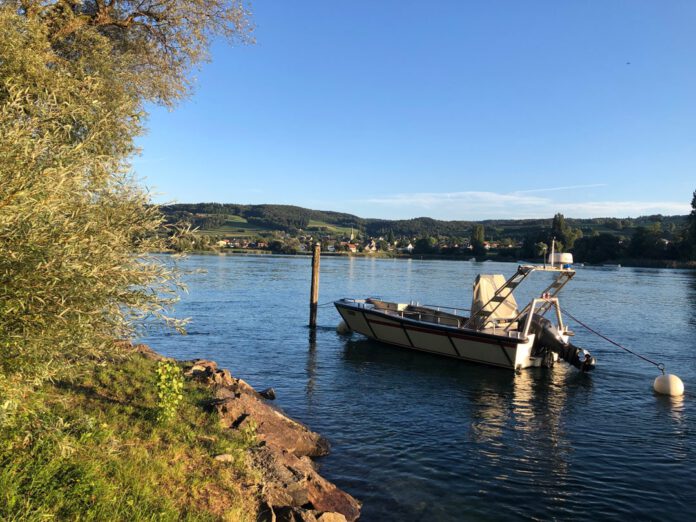The tranquil peninsula of Höri is located on Lake Constance — between Radolfzell and the Swiss town of Stein am Rhein. Throughout the last century, it enchanted numerous artists. The painter Otto Dix was one of them and stayed for over thirty years — until his death 55 years ago.
The Dix family villa sits high above the Untersee, the smaller part of Lake Constance, surrounded by lush greenery. From the windows with white muntins, you can gaze across to the opposite shore of Steckborn in Switzerland. During the summer months, motor and sailboats bob in front of the small bathing area below the house. Birds chirp in the trees deeply rooted to withstand the strong winds that occasionally sweep over the lake. The colourful flowers signal the onset of summer in the garden, still planted much like during the Dix family’s time. Since 2013, the former family residence has been part of the Stuttgart Art Museum, home to one of the most significant Dix collections globally. The restoration preserved the character of the rooms where Otto Dix lived with his wife Martha and three children. In the ground floor music room, the black grand piano awaits to be played. The dining and living rooms invite visitors to linger — with the help of the media guide, guests immerse themselves in the family’s life and listen to their stories during the tour.
…

Martha had the Dix family villa built thanks to an inheritance.
…
A wooden staircase leads to the first floor, passing by Anita Berber. The famous portrait of the dancer is not an original, as it hangs in the State Capital Museum. The woman in red with sunken cheeks appears emaciated, her thin body outlined beneath her dress. Yet, her portrait captivates passersby. The reproductions of the originals that once adorned the entire house are meant to be recognizable as such. To emphasize the temporal distance from the present, the images seem to have left a colourless imprint on the wall over the years. Otto Dix’s studio, belonging to one of the most renowned painters of the 20th century and a key figure of New Objectivity, gives the impression of a brief creative pause with its painting tools and easel. It feels as if the master will return from a stroll through ‘Paradise’ soon. Dix referred to Höri as “a beautiful paradise, disgustingly beautiful,” whenever he missed the big city and his Berlin life, which he abandoned forever in 1933 after the Nazis seized power.
…

The church tours in Kattenhorn focus on the biblical motifs of the windows.
…
Hidden Wall Paintings
Next to the studio is Martha’s salon, and above it are the children’s rooms of Nelly, Ursus, and Jan. Public tours also venture into the cellar. Here, Dix and some of his guests apparently painted the walls during a carnival party. The figures of the Alemannic carnival appear as lively as they did nearly sixty years ago. Alongside them are caricatures of friends or famous personalities. The wall paintings remained unknown for a long time, well concealed behind cellar shelves. During restoration, they were rediscovered. The scenes depict festive gatherings that supposedly took place in the house — Dix’s attempts to bring a touch of urban flair to Höri. Therefore, the artist, born in Gera, never abandoned his Dresden studio.
…

From the dining room, you can see across the lake to the Swiss shore.

The children were allowed to keep their father company in the studio.
…
Not only Otto Dix sought refuge from the Nazis on the idyllic peninsula near Switzerland. The painter Max Ackermann spent the war years in Hornstaad after losing his teaching position in Stuttgart. The bridge painter Erich Heckel arrived on Höri in 1944 and, like Dix, stayed until his death. Their graves are located in the Hemmenhofen cemetery. Hermann Hesse, Ludwig Finckh, and Helmuth Macke also lived on Höri. The Hesse Museum and the garden of the Mia and Hermann Hesse House in nearby Gaienhofen, towards Radolfzell, are open for visits. In Wangen, towards the Swiss border, the Archaeological Museum delves into the cultures from the fifth to the first millennium BC. The pile dwellings, well-hidden underwater, are among the oldest at Lake Constance and part of the UNESCO World Heritage. Just under five kilometres away, along the lakeshore, lies Kattenhorn. Above the Mediterranean-like village stands the evangelical Petrus Church, for which Otto Dix designed several windows depicting biblical scenes. Their expressiveness and vitality change with the sunlight. Just before the Swiss border, the lake merges into the Rhine. On a small island here lies the Werd Monastery, connected to the land by a wooden footbridge — far from everyday life. The medieval town of Stein
